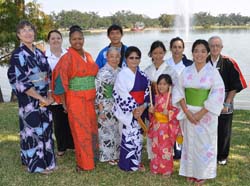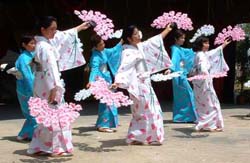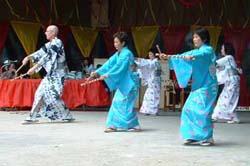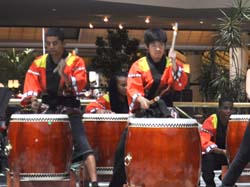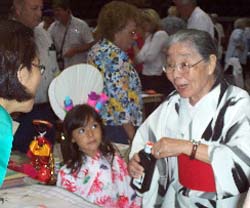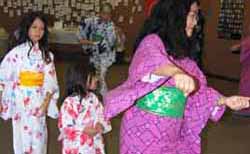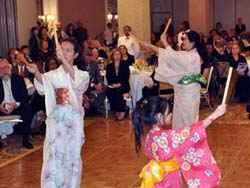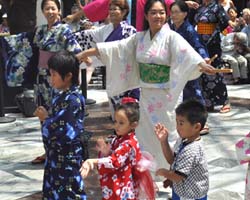Japanese Culture and Dance in Southeast Louisiana
By Laura Westbrook
Dancing is a way for me to enjoy my culture, and it is also a way to share the culture with other people. I hope more will want to do it, but the Japanese community in this area is very small. There are some more people in Baton Rouge who come and dance with us for festivals or special occasions, but not enough people here to really maintain a strong dance group with many active members. Right now, Ms. Sugai Barker and I are the one who keep the group together and arranges the practices and the different performances. I will keep doing this because it is important to me, and I am teaching my daughters to do the dancing as well. They are very good at it and they enjoy it. I think that the purpose of folk culture is to socialize among folks; that is why dances are not that difficult. I am doing this to create a place for my family to socialize and enjoy Japanese culture among other Japanese people-to have a good time.
-Sanae Keyser
Introduction
Like most immigrant communities, Japanese residents of Louisiana balance their interests in assimilation with their desire for cultural preservation. Maintaining "Japanese culture" can be difficult in a small community whose members arrived as individuals rather than in a group, or even during a particular decade. This is interesting in that Louisiana is home to locals of Japanese heritage of all ages, some with culturally-blended families, from various areas of Japan, so that local residents have more than one way of cooking, dancing, and celebrating holidays. Nevertheless, there is a definite sense of community among Japanese-Louisianans, with a (generally-agreed-upon, and much-appreciated) core group of folks who organize cultural events, maintain and teach traditional arts, and even encourage a sense of belonging by sharing invitations and news. Sanae Keyser, who arrived fresh from high school and chose to remain here after graduating from Tulane University, is valued for her infectious enthusiasm and effectiveness in all these areas. For that reason she was honored with the 2010 Asian Community Award by the Asian Pacific American Society. Sanae points out that communities [within a cultural group] can be created, but traditions acquire their own meaningfulness when maintained over time and in families.
Overview
At the time of the 2000 census, the total population of Japanese residents in Louisiana amounted to 1519 individuals. As of 2010 the number is probably a bit higher, but not by much. According to community members, the majority of Louisiana's Japanese residents live in the greater New Orleans area. Though the community is not large, members keep in touch socially and through a monthly newsletter distributed by the Japan Club of New Orleans. In an effort to include non-Japanese spouses and interested friends, the newsletter is printed in both Japanese and English, and the club has a "Japanese Vice-President" and an "English Vice-President." The Japan Club is predominantly Japanese-American and includes many Issei (first-generation, direct immigrants from Japan), Nissei (second-generation, first-born in the United States), Sansei (third generation), and Yonsei (fourth generation), while the Japan Society is more mixed.
Members of horticultural groups such as Ikebana International, the Greater New Orleans Bonsai Society, and the Japanese Garden Foundation of New Orleans, are largely non-Asian. The formal Japanese garden, named Yakumo Nihon Teien (Nihon - Japanese, Teien - garden, Yakumo - refers to New Orleans writer Lafcadio Hearn), in City Park was established by the latter group working with a local non-Asian architect. Other mixed groups include the New Orleans Haiku Society, the New Orleans Zen Temple, the Go (a board game) Club, the Greater New Orleans Suzuki Forum (appreciation of classical and folk music), the Japanese Weekend School of New Orleans (teaches crafts and origami-ornament making), and various other groups devoted to special interests such as martial arts.
As of yet, churches do not function as primary meeting places for Japanese in Louisiana. Japan allows complete freedom of religion, and houses of worship are not oriented toward membership rolls or exclusivity. Most Japanese people are familiar with tenets of ancient Shinto and Buddhist belief, and now also with Christian teachings, and each person adapts aspects of his or her spiritual education into their own particular belief system. Worship is more likely to be part of everyday family life, and includes visits to shrines, temples, and spiritual gathering places. It remains to be seen whether this will change as Sansei and Yonsei, and their children, grow up in the more compartmentalized religious culture of the United States.
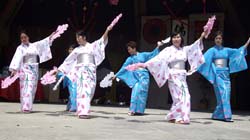
A synthesis of information on Asian cultures in the United States assembled in 1990 by Edward Lazzerini of the University of New Orleans' Center for the Pacific Rim reports that, among Asian immigrant cultures, Japanese are third in population size to Chinese and Filipinos, more than double the next most populous group, "Asian Indians"-this was the first census in which Japanese were not the most populous Asian group since the early 19th century. Its statistical charts illustrate that approximately 6.5 percent of the total population of Japanese Americans live in the northeastern, midwestern, and southern quadrants of the United States, while just over 80 percent of Japanese American live in the West; that just over a quarter of Japanese-Americans were born in Japan; that Japanese is spoken in roughly 44 percent of households; and that, though Japanese are about average in number of college graduates, they have the highest per-capita incomes and the lowest poverty rate.
The first Issei to settle in Louisiana differed from immigrants arriving from many other countries in that, though they tended to be of the agricultural class, they had received at least 8 years of education, which is mandatory in Japan. Moreover, Japanese government-imposed strictures required a rough balance of male and female emigrants in order to provide stability to new Japanese-American communities and to avoid the crime and other reported problems among communities of predominantly unmarried young male immigrants.
From the turn of the century until after World War II, the total Japanese population in Louisiana (according to census records dating back to 1900) remained below sixty. However, the city of New Orleans was home to the first reported Issei, Tomematsu Himata, who arrived on April 1, 1904. His import-export shop, the Japanese Art Store, operated on Royal Street in the French Quarter until December 8, 1941-the day after the bombing of Pearl Harbor. Other than Mr. Himata's arrival and shop records, only anecdotal evidence remains of Japanese residents in the greater New Orleans area until some of the Japanese who had been sent to internment camps chose to resettle in Louisiana rather than return to their previous homes. By 1950, the still-small Japanese population had tripled to comprise 63 men and 64 women. Since that time, the Japanese-American population continues its steady but slow growth. Japanese immigrants do not arrive as escapees from organized violence and persecution but as individuals who relocate for their own personal or professional reasons.
When they arrive in Louisiana, new immigrants from Japan find a well-assimilated, loosely-knit community whose members nevertheless know each other and retain the values brought from the home country. They will find grocery items at the Asian Gourmet Market in Kenner and, to a lesser extent, in the international aisle of most local grocery stores. They will also find an ever-growing number of Japanese restaurants, from the well-known (Ninja, Kyoto, Sake Café, Shogun, and now Wasabi) to new places that specialize in noodles and other traditional staples. Cultural traditions unrelated to food are less public and can be harder to learn about, but there are a few residents of Japanese descent who maintain and teach various customs and arts to their own families as well as to members of the wider community.
Holidays
Louisiana's Japanese residents primarily celebrate the same holidays as are observed in the larger American culture, with the addition of Bonenkai in late December (spellings can differ) and Bon Odori in mid-summer. Shogatsu (celebration of the New Year) is the biggest holiday in Japan, and festivities include both American and Japanese customs.
Bonenkai is a relatively new custom, and in Japan it is associated with the workplace. It is a day on which strict power hierarchies are relaxed, and on which end-of-year parties are held in the workplace. Bonenkai literally means "forget the year party;" it is preceded by a time of intense effort, during which workers tie up all possible projects that would otherwise drag into the new year. The parties, marked by equal measures collegiality and indulgence, are a time to let off steam and have one's hard work recognized. In the greater New Orleans area, because Japanese individuals are almost always in the minority in their workplaces, Bonenkai is celebrated as a community holiday. The Japan Club and other small organizations organize parties for their members, usually at area Japanese restaurants. At these parties people sing, eat, and drink, but the parties, unlike those in Japan, may also include children, and they are not too different from other winter holiday parties.
Christmas is not a national holiday in Japan. In fact, those who were born in Japan report knowing some Japanese children who were confused by Christmas because it comes so close to the birthday of the Emperor, December 23rd, which is a national holiday. In the United States, however, people have increasingly begun to decorate trees, serve Christmas cakes, and exchange presents with family and friends, regardless of their spiritual beliefs. Some residents who were interviewed for this essay explained that it is considered polite to observe the customs of their adopted homeland, and of course children who grow up in the United States embrace the holiday in many different ways. During the December holiday couples often will enjoy a special restaurant dinner and entertain groups of friends at home.
The term Shogatsu refers to the 1st, 2nd, and 3rd days of the New Year rather than to just one day. Although the Japanese lunar calendar is based on the Chinese, the Japanese year begins on January 1st rather than in February, as does the Chinese year. (The Japanese zodiac shares the Chinese 12-year cycle. 2007 was the Japanese Year of the Boar. It was followed by the 2008 Year of the Rat; then the Ox; next the Tiger; and in 2011, the Rabbit. 2012 is the Year of the Dragon; 2013 the Snake; followed by Horse, Sheep, Monkey, Rooster, and Dog. The cycle begins again in 2019, once again a Year of the Boar.) The days before and after January 1 are traditionally reserved for relaxation and family togetherness. Activities may include having one's hair cut, purchasing new clothing, or otherwise preparing to meet the coming year. Meals tend to be prepared in large portions so that leftovers will be easily available and no strenuous cooking will be required during Shogatsu. They may include some items that hold symbolic value and augur good luck for the coming year, such as shrimp (their bent backs represent living to an old age), long noodles (also represent long life), fish eggs (fertility), and bamboo shoots (health, growth). Some couples and families in Louisiana continue the practice of greeting the first sunrise of the New Year together.
The Bon Festival is held each year in mid-summer (mid-July or mid-August), to welcome the souls of ancestors who visit at that time and to pray for the repose of their souls. The beginnings of this ancient holiday are not documented, but historians believe it traces back to both Shinto and Buddhist custom. It and New Year's are the most popular annual celebrations. Like the New Year celebration, Bon extends for several days, and in Japan many people get leave from work to visit family in their hometowns and celebrate. This time of the year is known for clogged airports, busy restaurants, and well-visited public parks.
In Louisiana, a very few people still light the mukae-bi, the welcoming flame that light the way for ancestors to be temporarily united with their families. Houses are cleaned in welcome, and small home altars are built and laden with offerings of fruit and vegetables. At the end of Bon, the spirit ancestors are bid good-bye with another bonfire called okuri-bi.
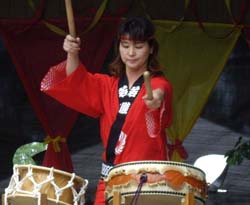
The largest and most notable aspect of this festive time is Bon Odori, the public dancing performed during Bon. The dances are very basic folk dances that many people know. Anyone unfamiliar with the dance, though, can join in and can easily learn. In Louisiana, the most public Bon Odori festivities have been held for the past several years at the Lakeside Mall in Metairie so that as many people as possible can be invited to join in and can learn about Japanese music and dance. Each year a program is presented that includes taiko drumming, traditional music, martial arts performances, and the main event-dancing. Sanae Kayser describes Bon and Bon Odori: "We greet our ancestors coming back to see us on the earth with folk dances, flowers and food on those days. There are many different folk dances that are unique to each regional culture. I grew up in an old city called Osaka City in Japan. Even though it is known to be a big high-tech city, people in Osaka like old culture and tradition, and I keep the traditions, even here. I particularly enjoy wearing Japanese clothing with my daughters."
Cultural Arts
There are a number of annual events at which Japanese cultural traditions are presented to the public, the largest of which is "Japan Fest," held each fall at the New Orleans Museum of Art and in the adjacent Dreyfous Meadow in City Park. The largest annual celebration of Japanese culture in the Gulf South, it features traditional music, dancing, martial arts demonstrations, and crafts. The majority of the performers and presenters come from other areas such as Houston, but the performers of Japanese country dances, artists and craftspeople, and demonstrators come from Orleans and Jefferson parishes in Louisiana.
Before the 2010 event, practitioners of origami gathered at space that was provided by Mr. Sakamoto at Kyoto II, his restaurant in Harahan, Jefferson Parish. Designs included stylized representations of natural forms such as flowers and fish; some were assembled into mobiles. One artist, Takako Dendinger, made zokin using fabric that had been part of a yukata, a casual, "everyday" kimono, usually made of cotton, commonly worn everywhere in Japan and indoors by many Japanese-Americans. In Japan, it has traditionally been part of a woman's responsibility to make the zokin, multi-layered dust rugs that resemble small quilts comprising folds or layers of squares stitched together, that are staples in every Japanese home. According to Teruko-san, each home contains an unlimited supply of zokin, and they are used to clean anything both inside-furnishings, shelves, and tatami--and outside--windows, play equipment, and bicycles. Like quilting, zokin-making is an old method of recycling, putting worn-out kimono--and now towels--to practical use. Teruko von Bargen also worked on zokin, and used yukata that had belonged to group members.
Calligraphy, though traditional, is considered a fine art that is properly acquired through formal training. At Japan Fest, Sugai Barker, Saeko Jensen, and Shinobu Yamamoto demonstrated their techniques and showed visitors how their names look when written in Japanese characters, doing their best to translate English letters. The many inquiries about whether Japanese artists offer classes in calligraphy and origami prompted Masako Lastrapes to wonder whether the Japan Club might be able to offer workshops in the future. "If we can provide for such demand, it would be [a] wonderful opportunity to introduce a part of Japanese culture to the community." The group currently has no clubhouse, so space would have to be negotiated.
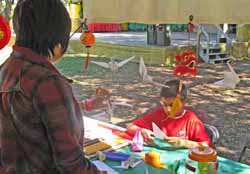
The Japanese tea ceremony, which could be described as a fine art performance, was presented inside the museum at Japan Fest as well. Women wearing dress kimono demonstrated the proper form, pacing, and technique for drawing maximum enjoyment from this venerated form of relaxation and hospitality, the rituals of which are highly structured. Members of the Tea Club, part of the Japan Club, pointed out that a proper ceremony would be performed in a very quiet and intimate setting, in a private home or in a teahouse-like Indian yoga aficionados, practitioners of Japanese tea ceremony believe that their skills develop over a lifetime and that no practitioner or ceremony can be considered "perfect."
It is considered that the best practitioners are women who came to Louisiana directly from Japan where they learned the ritual. In Japan, young women study the ritual and sometimes are taught it in "bride's school" a finishing-school-like atmosphere in which one learns traditional arts such as tea ceremony and ikebana, and to sew kimono and household linens. Those in the New Orleans area who maintain and teach tea ceremony include Kumiko Akama, Katsuo "Katie" Arimura, Katsuo Cox, Kuniko Izumi, Kayoko Kobori, Hiroko Kusuda, Toshiaki Shinoda, Fuki Williams, Junko Yano, and Liqin Zheng.
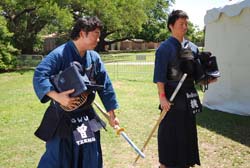
Judo and karate are popular with Asian and non-Asian young men, and a growing number of young women. Two of the most prominent masters in the United States are Japanese-born residents of the greater New Orleans region. Dr. Nobuo Hayashi, Ph.D., president of the Shinnanbu Judo Black Belt Association, established the Hayashi Judo School in Uptown New Orleans. Mr. Takayuki Makami, 8th Dan (degree black-belt), is the highest JKA-ranked (Japanese karate Association) master in the United States, and has provided instruction at many prestigious master clinics. Mr. Makami shares his knowledge and skills with Japanese and non-Japanese students, creating such organizations as the Tulane Karate Club in the 1960s. In 1990, Black Belt magazine named him "Instructor of the Year in American Karate." Following the efforts of these two trailblazers, Asians and non-Asians have become certified to open their own dojos (training facility or school) for students ranging from post-toddlers to adults.
The discipline of aikido is gaining in popularity with men and boys, and it is attracting increasing numbers of girls and women, in part because it is strictly for self-defense and is more about movement than force. Some take lessons as mental and physical exercise in the way that others practice yoga or Chinese tai chi, as aikido aims to promote bodily health and heijo shin (an unperturbed or calm mind). Traditionally, aikido's techniques are practiced in pairs, and the graceful motions are often compared to classical dance. In contrast to some other martial arts, the object is not to meet force with force or resistance, but to move with, and redirect, the force of an attack in order to maintain the safety of both people. Kaori Keyser takes children's lessons at Aikido of New Orleans on Magazine Street, and says, "Aikido is designed to fight without force. It is great for girls." This dojo makes presentations at Japan Fest every year.
Public presentations of martial arts by students at local dojos at the Bon Odori festival, Japan Fest, and the Asian Heritage Festival are always well-attended. Those interested in these disciplines can learn more about them by speaking with a sensei (master/instructor) after the presentations than they can from the performances themselves; these displays of skill are so thoroughly choreographed that they resemble a dance more than a battle.
Minyo Dance
One of the most popular of locally-maintained traditional art forms is dance. Minyo dancing, which originated in rural, agricultural Japan, is presented at Japan Fest, at the Asian Heritage Festival sponsored by the Asian Pacific American Society (APAS), and at Bon Odori each year. In 2010 the Minyo dance group of greater New Orleans, a group that began as part of the Japan Club, was invited to perform at the annual Louisiana Folk Festival at Northwestern State University in Natchitoches. The current Minyo group was established by Sanae Keyser and Sugai Barker. Mrs. Barker, called "Sugai-san" by admirers and pupils, has been dancing with members of the Japan Club since its inception about 30 years ago. 10 years ago, the two women established a casual group that meets to dance and to share fellowship and (traditional and non-traditional) food. The group also holds celebrations for holidays and special occasions. Sugai-san, a retired teacher who immigrated to Louisiana in the mid-1940s when she was about 20, says, "We are lucky to have the Slidell library where they let us use the room at no charge. We dance to socialize, exercise, and have a good time. No matter your age, it is important to keep moving!" In addition to dance, Mrs. Barker does calligraphy and sumie (highly-refined ink painting), and sews Japanese cloth.
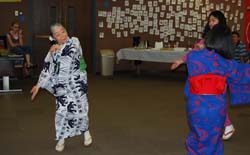
The word Minyo translates roughly as "folk song;" the dances developed over time to accompany specific songs. The songs and dances are distinct to their areas of origin, and knowledgeable onlookers can discern the home region of each piece. The dances have their roots in traditional daily life, and can generally be divided into four categories: work songs; spiritual songs (some of these represent the dancers' comforting of visiting spirits); special-occasion songs; and children's songs. One way in which the Metairie Bon Odori differs from Bon Odori in Japan is that, in Japan, each festival features dances from its own region. Because Louisiana's Japanese residents hail from a variety of regions in Japan, the dances included in the Louisiana Bon Odori do also.
The best places to see the group perform are at the Metairie Bon Odori mentioned earlier, and at the Asian Heritage Festival held each spring in New Orleans. For the past several years, it has been held at the Audubon Park Zoo. The most spectacular aspect of the event, for this writer, is the variety of dance traditions from many Asian countries and regions. APAS president Vatsana Chanthala concurs, "Even though many other [music and craft] traditions are not currently maintained by Asians in Louisiana, most Asian cultural groups here do feel that it is important to dance, even though most of them only do it only in practice sessions and for festivals."
Minyo songs were originally sung without accompaniment but, over the years, traditional lutes, drums, and bamboo flutes have been added, as has recorded music. The songs and dances, which describe the lives of traditional working men and women in fields and on the water, are simple and repetitive. Some of the work songs include call-and-response patterns similar to those of work songs and chants of the rural United States. Most are "circle dances," in which dancers form a large circle and each individual moves forward in the same direction. Each dance acts out the narrative of the song in a fairly literal, easy to understand way.
Sometimes the dances incorporate props representing items used in the everyday lives of their earliest dancers, such as parasols (for dances that focus on various aspects of rain), hats (used for shielding one's face from the sun), or fans (symbols of luck). The costumes, also, help to dramatize each dance's story. Light summer yukata are worn for dances that tell of summer events, a kimono held in place by an obi (a belt, wrapped around the waist and tied in the back) may be worn, or a happi (jacket) and hakama (trousers). On the feet, tabi (socks that separate the big toe from the other toes) allow for the usual geta (wooden thong-style sandals).
The Minyo stance differs from those of dances that include jumps and otherwise represent attempt to reach heavenward. The movements of Minyo require bent knees and a low center of gravity, as do the motions of crop pickers and net fishermen. The emphasis on remaining close to the ground is thought to illustrate the Japanese desire to remain in harmony with the earth. Among the work songs with accompanying dances performed most often are Tankoh Bushi, Coal Miner's Song, which features stylized motions of digging, hanging up a lantern, and pushing a cart loaded with ore; and Hokkai Bon Uta, Northern Fishermen's song, a song from the island of Hokkai that represents both the fisherman's life and respect for the ancestors. A shin-min'yo (new minyo) popular with the local dance group is Tokyo Ondo, which was composed in 1933 to celebrate the might of Tokyo and of Emperor Showa. Another is Kawachi Otoko Bushi, a "drum dance" popular in Osaka that incorporates drums and hand movements, and was recorded by the pop star Mitsuko Nakamura. Minyo continues to thrive as a music and dance form; the fact that new, tradition-based songs continue to be written, and accompanying dances shared from one dancer to another, at festivals, and on YouTube, bodes well for this art form's longevity.


